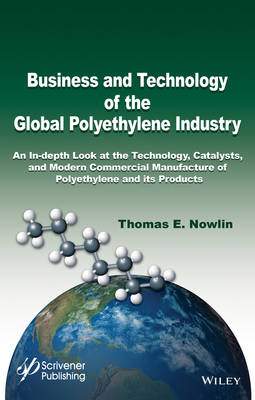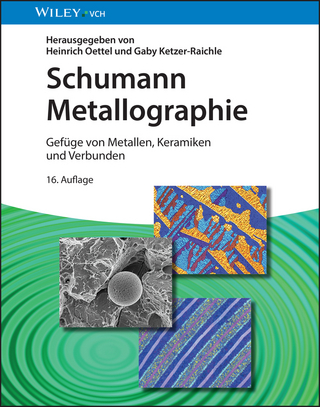
Business and Technology of the Global Polyethylene Industry
Wiley-Scrivener (Verlag)
978-1-118-94598-8 (ISBN)
- Titel z.Zt. nicht lieferbar
- Versandkostenfrei innerhalb Deutschlands
- Auch auf Rechnung
- Verfügbarkeit in der Filiale vor Ort prüfen
- Artikel merken
The book outlines the processes used for the manufacture of polyethylene are reviewed which include the high-pressure process and the three low-pressure processes; slurry, solution and the gas-phase methods. The techniques used to fabricate polyethylene into end-use products are reviewed with a discussion of blow-molding, injection molding, rotational molding, blown-film, cast-film and thermoforming are also discussed in detail.
Thomas E. Nowlin received a B.S. in Chemistry from the University of Iowa in 1967, Ph.D. in Chemistry from Michigan State University in? 1971, and an M.B.A. degree from Rutgers University in 1982. He was commissioned a second lieutenant in the USAR Chemical Corps in February 1971 and served two years active duty at Edgewood Arsenal, Maryland, from 1971 to 1973. He retired as a LTC from the USAR Chemical Corps in 1989 with 20 years of service. Dr. Nowlin was a research chemist for Union Carbide Corporation from 1973-1979 in Bound Brook, New Jersey, and worked for Mobil Chemical company, Edison, New Jersey, as a research chemist? from 1980-2000. He investigated olefin polymerization catalysts from 1977-2000 and received over 65 U.S. patents for Mobil Oil Corporation, mostly in the area of Ziegler and metallocene catalysts for ethylene polymerization. He has published over 30 papers in chemical journals from 1971-2009.
Preface xviii
1. Global Polyethylene Business Overview 1
1.1 Introduction 1
1.2 The Business of Polyethylene 2
1.3 Cyclical Nature of the Polyethylene Business 2
1.4 Early History of Ethylene and Polyethylene Manufacturing 6
References 44
2. Titanium-Based Ziegler Catalysts for the Production of Polyethylene 47
2.1 Introduction 47
2.2 Titanium-Based Catalyst Developments 47
2.3 Titanium-Based Catalysts for the Manufacture of Polyethylene 52
2.4 Second Generation Ziegler Catalyst for the Manufacture of Polyethylene 62
2.5 Catalysts Prepared on Silica 76
2.6 Characterization of Catalysts Prepared with Calcined Silica, Dibutylmagnesium or Triethylaluminum and TiCl4 82
2.7 Kinetic Mechanism in the Multi-site Mg/Ti High-Activity Catalysts 96
References 104
Appendix 2.1 107
3. Chromium-Based Catalysts 109
3.1 Part I - The Phillips Catalyst 109
3.2 Part II - Chromium-Based Catalysts Developed by Union Carbide 126
3.3 Next Generation Chromium-Based Ethylene Polymerization Catalysts for Commercial Operations 164
References 165
4. Single-Site Catalysts Based on Titanium or Zirconium for the Production of Polyethylene 167
4.1 Overview of Single-Site Catalysts 167
4.2 Polyethylene Structure Attained with a Single-Site Catalyst 169
4.3 Historical Background 172
4.4 Single-Site Catalyst Based on (BuCp)2ZrCl2/MAO and Silica for the Gas-Phase Manufacture of Polyethylene 193
4.5 Activation of the Metallocenes Cp2ZrCl2 or (BuCp)2ZrCl2 by Solid Acid Supports 197
4.6 Dow Chemical Company Constrained Geometry Single-Site Catalysts (CGC) 202
4.7 Novel Ethylene Copolymers Based on Single-Site Catalysts 205
4.8 Non-Metallocene Single-Site Catalysts 207
4.9 New Ethylene Copolymers Based on Single-Site Catalysts 211
4.10 Compatible Metallocene/Ziegler Catalyst System 215
4.11 Next Generation Catalysts 217
References 219
Appendix 4.I 222
5. Commercial Manufacture of Polyethylene 223
5.1 Introduction 223
5.2 Commercial Process Methods 226
5.3 Global Polyethylene Consumption 228
5.4 High-Pressure Polyethylene Manufacturing Process 229
5.5 Free-Radical Polymerization Mechanism for High-Pressure Polyethylene 243
5.6 Organic Peroxides as Free-Radical Source for Initiation Process 246
5.7 Structure of High-Pressure LDPE 248
5.8 Low-Pressure Process 255
5.9 Gas-Phase Process 274
5.10 Gas-Phase Process Licensors 290
5.11 Solution Process 294
5.12 DuPont Sclair Process 295
5.13 Solution Process (2012) 298
References 300
6 Fabrication of Polyethylene 303
6.1 Introduction 303
6.2 Early History of Polyethylene Fabrication (1940-1953) 308
6.3 Stabilization of Polyethylene 310
6.4 Historical Overview of Some Common Polyethylene Additives 316
6.5 Examples of Additives Presently Used in the Polyethylene Industry (2012) 318
6.6 Rheological Properties of Polyethylene 326
6.7 Fabrication of Film 327
6.8 Blown Film Extrusion 328
6.9 Fabrication of Polyethylene with Molding Methods 341
6.10 Rotational Molding 355
6.11 Thermoforming 357
References 359
7. Experimental Methods for Polyethylene Research Program 361
7.1 Introduction 361
7.2 Experimental Process 363
7.3 Important Considerations for Laboratory Slurry (Suspension) Polymerization Reactors 368
7.4 Polymerization Reactor Design for High-Throughput Methods 391
7.5 Polymer Characterization 393
7.6 Process Models 393
References 394
| Erscheint lt. Verlag | 14.11.2014 |
|---|---|
| Sprache | englisch |
| Maße | 163 x 243 mm |
| Gewicht | 739 g |
| Themenwelt | Naturwissenschaften ► Chemie |
| Technik ► Maschinenbau | |
| ISBN-10 | 1-118-94598-0 / 1118945980 |
| ISBN-13 | 978-1-118-94598-8 / 9781118945988 |
| Zustand | Neuware |
| Informationen gemäß Produktsicherheitsverordnung (GPSR) | |
| Haben Sie eine Frage zum Produkt? |
aus dem Bereich


